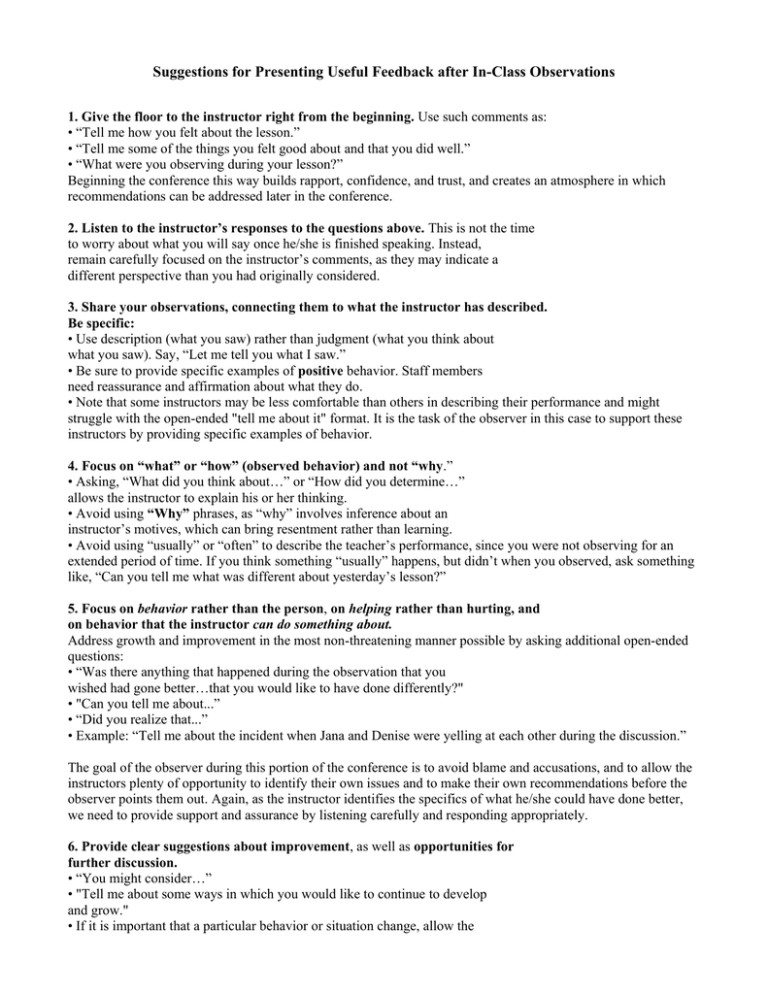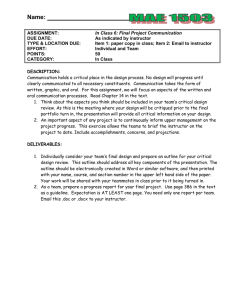Suggestions for Presenting Useful Feedback after In-Class Observations
advertisement

Suggestions for Presenting Useful Feedback after In-Class Observations 1. Give the floor to the instructor right from the beginning. Use such comments as: • “Tell me how you felt about the lesson.” • “Tell me some of the things you felt good about and that you did well.” • “What were you observing during your lesson?” Beginning the conference this way builds rapport, confidence, and trust, and creates an atmosphere in which recommendations can be addressed later in the conference. 2. Listen to the instructor’s responses to the questions above. This is not the time to worry about what you will say once he/she is finished speaking. Instead, remain carefully focused on the instructor’s comments, as they may indicate a different perspective than you had originally considered. 3. Share your observations, connecting them to what the instructor has described. Be specific: • Use description (what you saw) rather than judgment (what you think about what you saw). Say, “Let me tell you what I saw.” • Be sure to provide specific examples of positive behavior. Staff members need reassurance and affirmation about what they do. • Note that some instructors may be less comfortable than others in describing their performance and might struggle with the open-ended "tell me about it" format. It is the task of the observer in this case to support these instructors by providing specific examples of behavior. 4. Focus on “what” or “how” (observed behavior) and not “why.” • Asking, “What did you think about…” or “How did you determine…” allows the instructor to explain his or her thinking. • Avoid using “Why” phrases, as “why” involves inference about an instructor’s motives, which can bring resentment rather than learning. • Avoid using “usually” or “often” to describe the teacher’s performance, since you were not observing for an extended period of time. If you think something “usually” happens, but didn’t when you observed, ask something like, “Can you tell me what was different about yesterday’s lesson?” 5. Focus on behavior rather than the person, on helping rather than hurting, and on behavior that the instructor can do something about. Address growth and improvement in the most non-threatening manner possible by asking additional open-ended questions: • “Was there anything that happened during the observation that you wished had gone better…that you would like to have done differently?" • "Can you tell me about...” • “Did you realize that...” • Example: “Tell me about the incident when Jana and Denise were yelling at each other during the discussion.” The goal of the observer during this portion of the conference is to avoid blame and accusations, and to allow the instructors plenty of opportunity to identify their own issues and to make their own recommendations before the observer points them out. Again, as the instructor identifies the specifics of what he/she could have done better, we need to provide support and assurance by listening carefully and responding appropriately. 6. Provide clear suggestions about improvement, as well as opportunities for further discussion. • “You might consider…” • "Tell me about some ways in which you would like to continue to develop and grow." • If it is important that a particular behavior or situation change, allow the instructor to set a time frame for doing so. For example, it is better to say, “How long do you think it will take you to _____(get the computer running, add posters to the walls, etc.)?” than “I expect to see ____ the next time I come in here.” 7. Review what you have discussed, as well as any recommendations. In order to avoid future misunderstandings and to make both parties accountable for commitments made during the conference we should review any recommendations and agreed upon time frames just prior to concluding the conference and express confidence in the staff member’s ability to accomplish goals and implement plans. 8. Conclude with the positive. It is still the responsibility of the observer to steer the conversation back toward the positive by restating the instructor’s strengths and expressing appreciation for their contributions, and when appropriate, their commitment to adults and the program. Ultimately, the observation process is an opportunity to learn, both for the instructor and the observer! References: http://www.wku.edu/Info/General/TTAS/lc/Feedbac2.htm http://www1.umn.edu/ohr/teachlearn/peer_review/feedback.html http://www.aelweb.vcu.edu/projects/observation/


